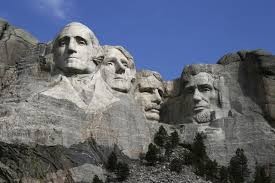Mount Rushmore National Memorial
Introduction
Text-to-speech Audio
Authorized on March 3, 1925, the monument of Mount Rushmore is used to represent the nation’s birth and development as a country. The presidents carved into the granite were initially started by Gutzon Borglum to increase tourism in the Black Hills area of South Dakota. During the build, 400 men and women labored through dangerous work to create what is now one of the most popular tourist attractions in the nation. Today, the 60 ft heads of George Washington, Abraham Lincoln, Thomas Jefferson, and Theodore Roosevelt stare out from Mount Rushmore representing how far the nation has come since the declaration of its independence from Britain. There is even a memorial park that houses this monument and visitors can look from an outlook post to check it out.
Images
Presidents George Washington, Thomas Jefferson, Abraham Lincoln, and Theodore Roosevelt were selected to be faces for Mount Rushmore standing for America’s birth, growth, development, and preservation.

Gutzon Borglum oversees work on Mount Rushmore

Backstory and Context
Text-to-speech Audio
Mount Rushmore was a plan to attract tourists based on showing the triumph of modern civilization while Indians that occupied the ground saw it as a loss of their land and injustices of their suffering under the U.S. Government. In the Treaty of 1868, the Latoka Sioux Indians were promised land, which included used the entirety of the Black Hills. However, white settlers came into the area after the discovery of gold was found in the area. This caused the government to force those Indians out of the Black Hills. This resulted in the Wounded Knee Massacre as the U.S. Army fought the Native Americans in 1890 where nearly 300 Indians (men, women, and children) were shot to death by U.S. troops.
At first, the plan was not to show the faces of popular presidents; in fact, the original plan included the carving of other famous figures on a completely different mountain, such as Chief Red Cloud from the Sioux tribe. Combating these intentions, Gutzon Burglum envisioned a mountain with the four presidents that are still there today, showcased from the torso up, however, limited funding caused the plan to change to only the heads of each individual. Historian Doane Robinson is known as the man for coming up with the idea of Mount Rushmore for his belief of it raising tourism in the area. South Dakota Senator Peter Norbeck helped secured funding and sponsored the construction of the memorial. Finally, a plan was complete and President Coolidge delivered his dedication speech on August 10, 1927.
Through 14 years of construction, 400 workers climbed 700 stairs daily just to start the job. However, much of the construction occurred during the Great Depression so a job and income was widely appreciated despite the dangers. Most of the 450,000 tons of rock removed was done by dynamite. Only the last few inches were finished by hand using drills and chisels.
In March, 1941, Gutzon died and left the finishing touches to his son, Lincoln. Later that year, the project was finally finished. In the coming years, a visitor center would be added, a museum for Lincoln Borglum was established detailing the work of Lincoln and his father, including their contribution to the construction of Mount Rushmore, and the Presidential Trail, a walking trail that leads up to the sculpture.
Now, the 60 foot heads of George Washington, Thomas Jefferson, Abraham Lincoln, and Theodore Roosevelt stand as a "Shrine of Democracy". This memorial was put on the National Register of Historic Places in 1966. A 500-word essay on Mount Rushmore by student William A. Burkett of Nebraska won first place in a 1934 writing contest. It would be emboldened in a bronze plate at the memorial in 1973. President George H.W. Bush officially dedicated Mount Rushmore in 1991.
Sources
“Mount Rushmore National Memorial,” National Park Service. Accessed July 22nd 2021. http://www.nps.gov/moru/learn/historyculture/carving-history.htm
“Mount Rushmore,” History.com Accessed July 22nd 2021.
http://www.history.com/topics/us-presidents/mount-rushmore
